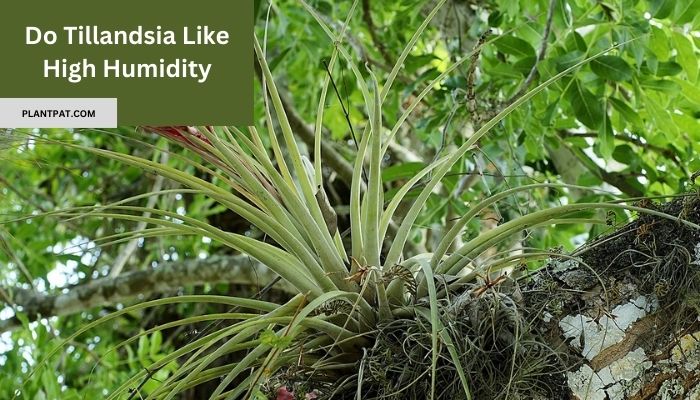
Tillandsia, commonly known as air plants, have become increasingly popular due to their unique appearance and easy care requirements. One of the most common questions that plant enthusiasts ask about Tillandsia is whether they require high humidity to thrive.
Yes, Tillandsia likes high humidity. These delicate beauties thrive when the humidity is between 50 and 85 percent. The increased moisture in the air facilitates photosynthesis for plants, which is a fundamental part of their well-being and development. For your Tillandsia to be its happiest, ensure the air around it is full of moisture!
Let’s learn about the relationship between humidity and Tillandsia and how to maintain the perfect humidity level for their growth.
How Does Humidity Affect Tillandsia?
Humidity plays a vital role in the growth and survival of Tillandsia. As epiphytes, Tillandsia absorbs nutrients and moisture through their leaves from the surrounding air, making them highly sensitive to humidity levels. Here are some ways in which humidity can affect Tillandsia:
- Growth and development: High humidity can help promote the growth and development of Tillandsia by providing the necessary moisture for photosynthesis, nutrient uptake, and overall plant health. On the other hand, low humidity can slow their growth and cause the plant to become brittle and dry.
- Reproduction: High humidity levels can also encourage Tillandsia to bloom and reproduce. When the air is humid, the plant can produce more buds, flowers, and offsets.
- Disease: Too much humidity can create a breeding ground for harmful bacteria and fungi, which can cause Tillandsia to develop rot or other diseases.
Humidity is essential for Tillandsia growth and survival, but it must be balanced properly to avoid adverse effects on the plant.
What are The Signs of Too Much Humidity for Tillandsia?
Regarding Tillandsia, humidity is important for their survival, but too much of a good thing can be harmful. Here are some signs that your Tillandsia is experiencing too much humidity:
- Fungus: If you notice a white, powdery substance on your plant, it could signify fungal growth, which thrives in high humidity.
- Rot: Tillandsia that is constantly wet can begin to rot, characterized by a soft, mushy texture.
- Discoloration: Overly humid conditions can cause Tillandsia leaves to turn yellow or brown, indicating that the plant cannot absorb nutrients properly.
- Insects: High humidity can also attract insects, such as gnats, which can cause damage to Tillandsia plants.
If you notice any of these signs, adjusting the humidity levels around your Tillandsia is essential to prevent further damage.
How to Create the Perfect Humidity Level for Your Tillandsia?
Maintaining the ideal humidity level is essential for the health and growth of Tillandsia plants. Here are some guidelines on creating the right conditions for your Tillandsia:
Choose The Right Location
The first step in creating the perfect humidity level for your Tillandsia is to choose the correct location. Look for a spot in your home that is naturally humid, like a bathroom or kitchen. This will make it easier to maintain the ideal humidity level for your plant.
Use A Humidity Tray
A humidity tray is an easy and effective way to increase the humidity around your Tillandsia. Simply fill a shallow tray with water and place it near your plant. As the water evaporates, it will create a humid environment perfect for your Tillandsia.
Mist Your Plant Regularly
Misting your Tillandsia regularly is another way to increase the humidity around your plant. Use a spray bottle to mist your plant with water once or twice daily. Be sure to use distilled water, as tap water can contain minerals that can harm your plant.
Group Your Plants Together
Grouping your Tillandsia can also help to create a humid environment. When plants are grouped, they release moisture into the air through transpiration. This can help to increase the overall humidity level in the area.
Use A Humidifier
If you live in a dry climate or struggle to maintain the proper humidity level for your Tillandsia, consider using a humidifier. A humidifier is an easy way to add moisture to the air, and it can help to create a more consistent and stable environment for your plant.
If you want your Tillandsia to reach its peak potential, follow these tips to create the ideal humidity level. Keep an eye on the humidity and adjust your care routine as needed – this will guarantee your plant is as happy as possible!
Is 100% Humidity Too High for Air Plants?
When it comes to air plants, a humidity of 100% is a bit too much of a good thing. When you first get your air plant, you’ll want to set the humidity around 80 – 85%, which is ideal for the growth phase.
As the plant matures and grows, dial back the humidity to around 60%, as too high of levels can cause it to become stunted.
Once the flowering phase begins, keeping the humidity below 50% is essential. Otherwise, the flowers wilt prematurely, and the plant just won’t thrive. So, remember: eighty-eighty-five, sixty-max, and fifty-or-bust, and your air plant can be happy and healthy!
The Best Air Plants For Humid Environments
If you live in a humid environment, you might wonder which air plants are best suited for your home. Luckily, many air plants thrive in high-humidity environments. Here are some of the best air plants for humid environments:
- Tillandsia bulbosa: This air plant has adapted to growing in the wet and humid forests of Central and South America, making it an ideal choice for high-humidity environments.
- Tillandsia xerographica: This air plant is known for its beautiful, silvery leaves and can handle a wide range of humidity levels, making it a great choice for humid environments.
- Tillandsia ionantha: This air plant is one of the most popular species and can tolerate high humidity. It is also easy to care for, making it a great choice for beginners.
- Tillandsia streptophylla: This air plant has curly, twisted leaves that give it a unique appearance. It is also well-adapted to humid environments and can thrive in various humidity levels.
- Tillandsia caput-medusae: This air plant is named after the mythological creature Medusa because of its snake-like appearance. It is native to Mexico and Central America and can tolerate high humidity.
Remember that air plants well-suited for humid environments still need proper care and attention. Ensure adequate air circulation and avoid overwatering to keep your air plants healthy and happy.
Conclusion
Humidity plays a crucial role in the growth and overall health of Tillandsia. While high humidity can be beneficial, strike a balance and avoid excess moisture, leading to issues like root rot and fungal infections. Creating the perfect humidity level for your air plants requires trial and error but can be achieved with the right tools and techniques.
Additionally, selecting the suitable species for your environment ensures your air plants thrive. Whether you’re a seasoned air plant enthusiast or just starting out, understanding the role of humidity in Tillandsia care is essential for achieving success and growing beautiful, healthy plants.
